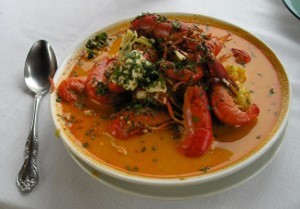Hello Berlitz! Hello Rosetta Stone! You think we want to speak Mandarin fluently in 30 days – HAH!
What we really want to know is the difference between “hashi” and “gohan” in a Japanese restaurant.
What is a glass of “palinka”? What the heck is “chupe de camarones”? Should I order the “murgh cholay” or not?

Nothing shows sophistication like being fluent in Menu. It is the language of pleasure and sustenance. It is a language, once mastered, that can amaze and entertain your friends. And give you great satisfaction in any number of restaurants.
No, we don’t want to be fluent in French, just French menu. We want to know enough to avoid the rognons but accept the agneau and sound sophisticated in doing it.
And yet there are no courses in Menu out there. There is only dining experience to gather new words and usage. It is like landing in a foreign country and learning by trial and unpalatable error.
Early and Middle Menu were not difficult – words like “roast beef” or “fish and chips” or “pizza” were not difficult to master.
But like most living languages, Menu, is rapidly evolving and escalating. Its vocabulary is expanding as new cuisines, techniques and dishes emerge. Sous vide anyone?
Becoming fluent in menu is not something that comes naturally, and there are no native speakers. I once asked a waiter for a bottle of Chateaubriand for two and the waiter seriously checked it out, carefully examining the wine list.
There is a constant arms race of obscure foodie terms that creep onto menus, trying to fool even the most fluent Food Network viewer. Learning Menu is an ongoing task. New words, new techniques, new sausages, cheeses, national dishes…. how can anyone keep up?
So, I want to start the Berlitz School of Menu. Learning and eating our way around the world, dining and absorbing culture. We’ll make a fortune!
Glossary: Chupe de camarrones is a Peruvian fish stew that includes cheese, potatoes, fish, peppers and, in this case, shrimps (camarrones). Hashi are chopsticks; gohan is rice. Palinka is a Hungarian eau de vie — eau de vie is a brandy made from fruit. Murgh is chicken and cholay is curried garbanzos or chick peas.